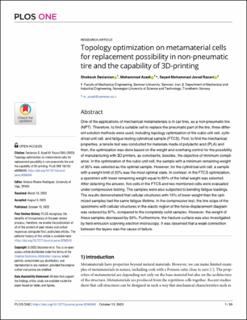| dc.description.abstract | One of the applications of mechanical metamaterials is in car tires, as a non-pneumatic tire (NPT). Therefore, to find a suitable cell to replace the pneumatic part of the tire, three different solution methods were used, including topology optimization of the cubic unit cell, cylindrical unit cell, and fatigue testing cylindrical sample (FTCS). First, to find the mechanical properties, a tensile test was conducted for materials made of polylactic acid (PLA) and then, the optimization was done based on the weight and overhang control for the possibility of manufacturing with 3D printers, as constraints, besides, the objective of minimum compliance. In the optimization of the cubic unit cell, the sample with a minimum remaining weight of 35% was selected as the optimal sample. However, for the cylindrical unit cell, a sample with a weight limit of 20% was the most optimal state. In contrast, in the FTCS optimization, a specimen with lower remaining weight equal to 60% of the initial weight was selected. After obtaining the answer, five cells in the FTCS and two mentioned cells were evaluated under compressive testing. The samples were also subjected to bending fatigue loadings. The results demonstrated that cellular structures with 15% of lower weight than the optimized samples had the same fatigue lifetime. In the compressive test, the line slope of the specimens with cellular structures in the elastic region of the force-displacement diagram was reduced by 37%, compared to the completely solid samples. However, the weight of these samples decreased by 59%. Furthermore, the fracture surface was also investigated by field-emission scanning electron microscopy. It was observed that a weak connection between the layers was the cause of failure. | en_US |

